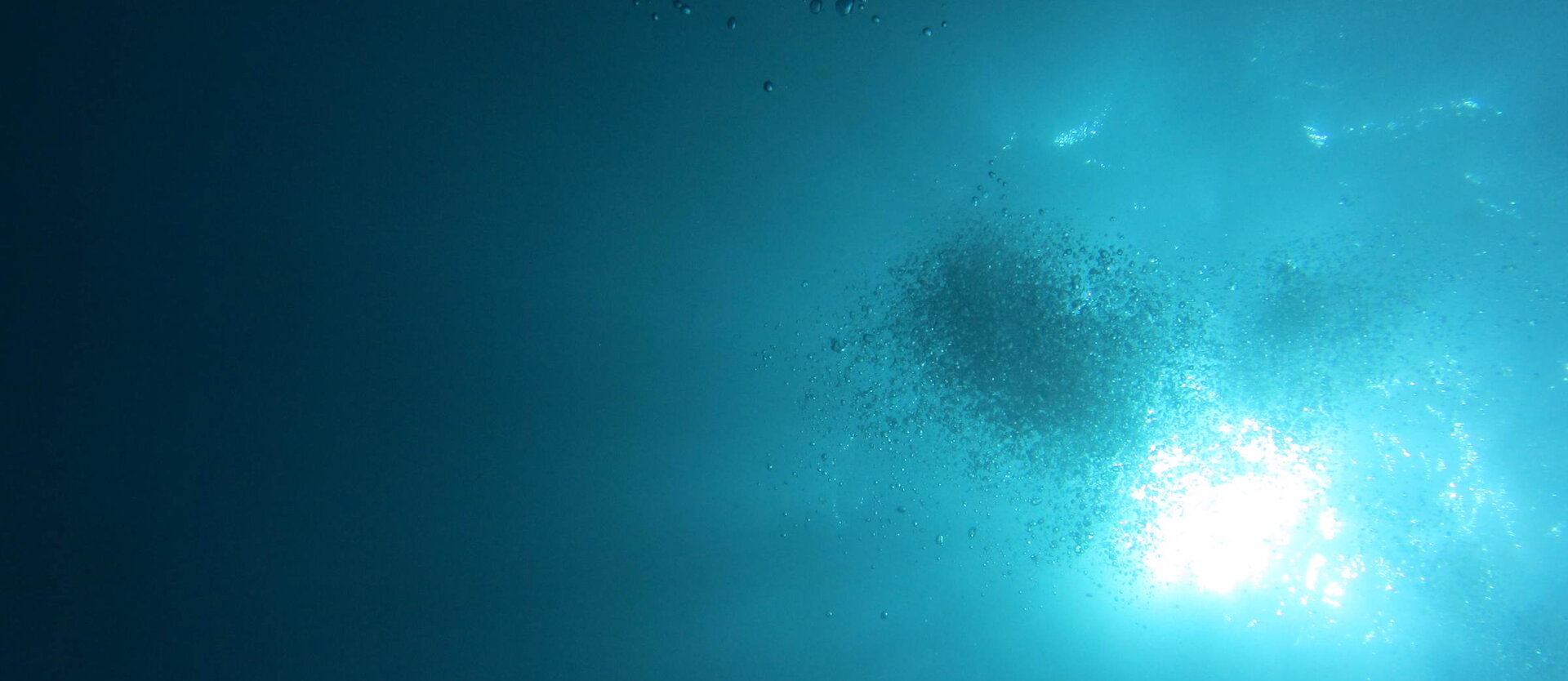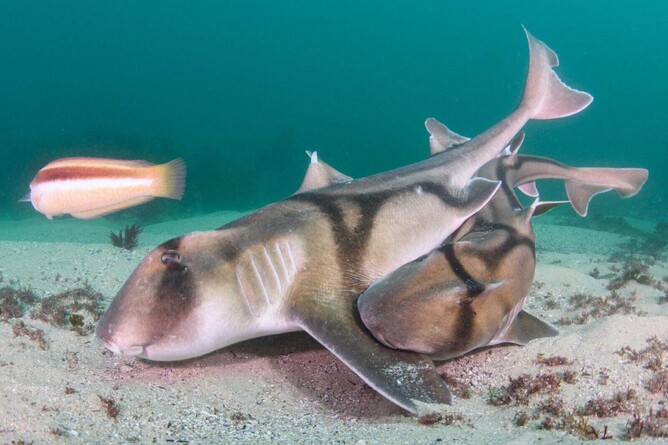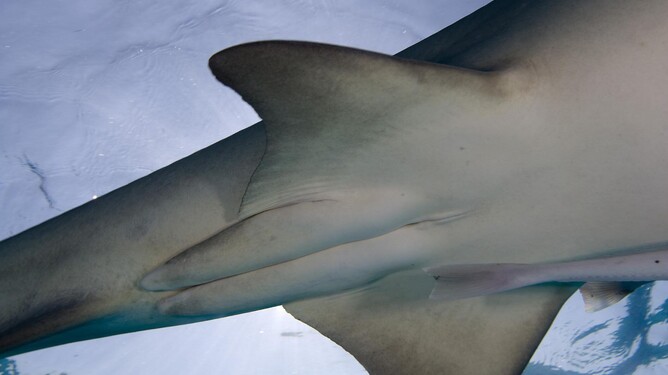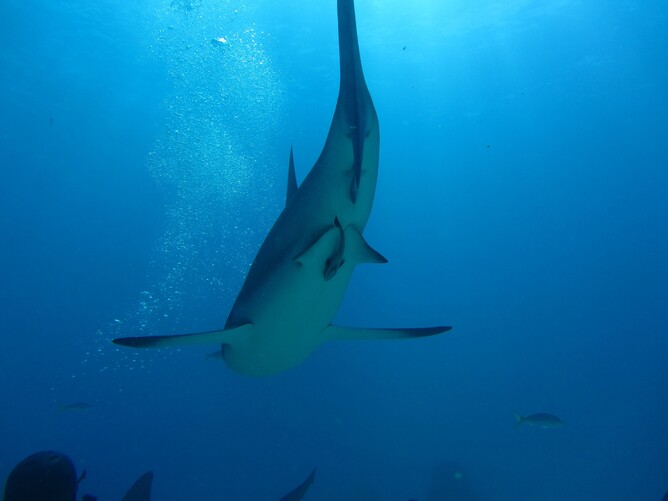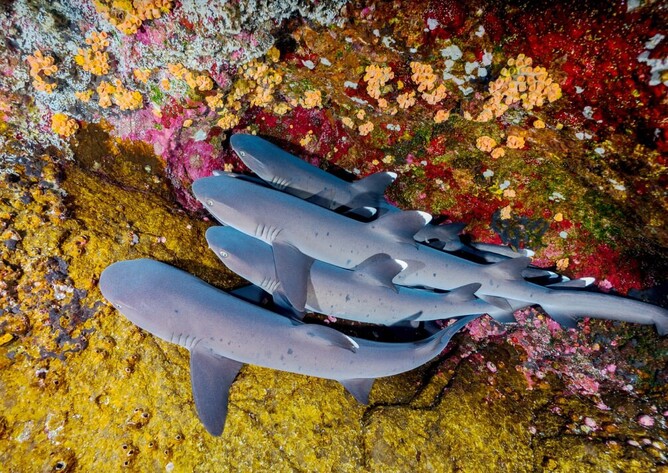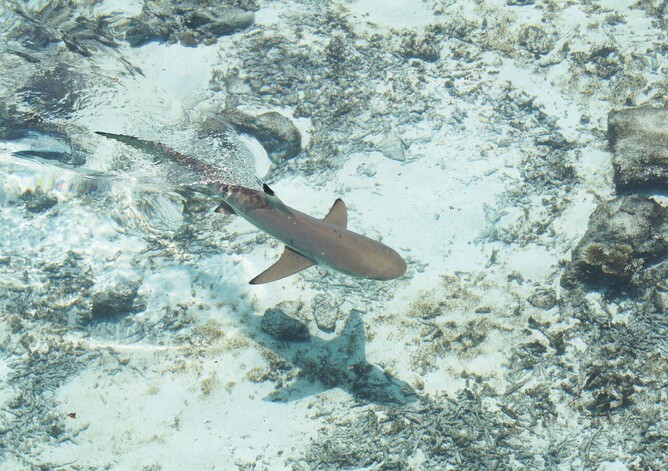This is the third in our series of 'I want to know about...' blogs. This one will cover the topic of shark reproduction.
Reproduction is vital to a species’ survival, and you’d be surprised how many different ways there are to do it. It’s ingrained into the survival instinct to reproduce and ensure that their genetics live on through offspring, and fish are the same! The majority of fish will lay eggs and have them fertilised externally, however sharks and rays are completely different (we’re going to focus on sharks in this blog). In fact, their breeding strategies are considered surprising, as it's practically unheard of for fish to breed the way sharks do.
Mating rituals begin for sharks when the female is ready - she will release chemicals into the water to attract males to her. Many species of shark like the Hammerhead or Great White will have complex mating rituals e.g. fighting, deep diving and even dancing together. The female will choose her ideal mate when he expresses interest - on the flip side if she deems him unsuitable there is no doubt when she rejects the male. Some species like the Nurse shark may choose to mate multiple times, and others are able to store semen for up to 2 years!
Mating in sharks is very rarely seen, especially in captivity so it is quite hard to study their mating habits at a scientific level. Sharks are also late maturing, which means that they may not reach sexual maturity until very late in their lives. For example, the greenland shark that can live for up to 400 years does not reach sexual maturity until it is 150 years old. This is another reason why they are so vulnerable to population decline, as many are killed before they even have the chance to produce offspring.
Claspers and Oviducts
To understand sharks’ reproduction tactics, it’s probably best that you’re familiar with their reproductive organs and how they use them.
Male sharks have 2 sex organs called claspers. Claspers are intromittent, which just means that they are external and used for the purpose of transporting sperm during copulation. They are located on their underbellies, along the inner sides of their pelvic fin. This is actually an easy way to identify whether a shark is male or female - put simply a male will have claspers, a female will not. Although a male is able to use both of his 2 claspers, he will only use one at a time. The male begins by swimming alongside the female he intends to mate with and raising whichever clasper he chooses - usually the one opposite to the side the female is on. The clasper has a specific orifice to siphon water into it. The male will insert one of his claspers into the female’s cloaca - the clasper will open like an umbrella to keep him anchored, and then the siphon contracts to expel the water and semen into her. Many species of sharks are observed to have hooks or spines to keep males further secured to the female. A lot of males are seen to also bite the female in various places to keep himself attached. Biting is also somewhat of a courtship ritual used for expressing interest in mating.
Female sharks utilise their cloaca (as mentioned above) and have oviducts. All sharks, whether female or male will have a cloaca. It is an opening on the underside of a shark, and they use it to dispel all waste products. However, where a female differs, is that her cloaca opens to her oviducts. Oviducts are essentially tubes that transport the semen from the male to the womb so that her eggs can be fertilised. In some species, female sharks have actually been observed to have thicker skin than males to protect her from the biting and hooking during mating.
Modes of Reproduction
There are many different modes of reproduction, however in this blog we’ll be focusing on 3 types. When it comes to fish, the average method is laying eggs that are either fertilised internally or externally, and they develop by themselves. There isn’t any internal development or nutrients gathered from the mother. This is known as oviparity. Surprisingly however, the sharks that reproduce similarly are in the minority of their species.
Oviparous
Although all sharks take part in internal fertilisation, they tend to branch out when it comes to laying eggs/giving birth. About 40% of sharks reproduce similarly to other fish, but not the exact same. They are oviparous, however they are known as specifically true oviparous. The difference is that the eggs are fertilised internally (this is what makes them ‘true’). So, the eggs are fertilised inside the female’s oviduct, and then the egg sac is laid somewhere. The eggs will stay in the mother for usually a few weeks before it is laid, and she may take a while actually laying them to ensure that they are secured before leaving. Depending on the species of shark, the female will lay anywhere between 10 and 200 eggs. The egg sac is described as being like a leathery purse - and this is why they are commonly called a ‘mermaid’s purse’. They also have tendrils that allow it to attach to different substrates (like coral, rocks or the seabed). The pups are nourished by the yolk inside the sac until they are ready to hatch. They can take between 6-9 months before they will hatch. After they hatch, they will all go their own way, ready to start life.
Examples of viviparous shark species:
- Zebra shark
- Salmon shark
- Bamboo shark
Viviparous
The other 60% of sharks will give birth to live young. Amazingly, there are some species of shark that have evolved to reproduce like us. This is known as viviparous, where the eggs are fertilised internally and the pups develop in the female’s oviduct. It is also referred to as placental viviparity because this method includes a placenta.
Only 10% of sharks use this method. With this method, the pups do not rely on the egg yolk for nutrients, they will rely on the mother - the yolk sac will become a placenta that attaches to the female’s uterine wall (the pups hatch early on). The pups will develop inside the female until they are ready and she can give birth. The gestation period varies between species - it can last from 7 months to 3 years! Typically, viviparous sharks will have smaller litters - between 2 and 20 pups.
Examples of viviparous shark species:
- Bull shark
- Hammerheads
- Lemon shark
- Mako shark
Ovoviviparous
Now, the majority of sharks are known as ovoviviparous. It is similar to viviparity, however there are a few key differences. You may sometimes see it referred to as aplacental viviparity. This is because there is no placenta present in this method. However, the mother's body does provide gas exchange (respiration).
The eggs are fertilised, and the pups will fully develop within their eggs relying on the egg yolk for nutrients and growth. The pups will hatch inside of the female (at approximately 3 months) and remain there feeding off of the remaining egg yolk and gland secretions until she gives birth to them, fully developed.
The first pup to hatch may eat some of its siblings too (fetal cannibalism). This method is the best for creating the most developed pups, as they will need to fend for themselves as soon as they are born, yet ovoviviparous sharks will have very small litters - 1 to 8 pups.
Examples of ovoviviparous shark species:
- Nurse shark
- Tiger shark
- Great White
- Thresher
- Sand Tiger
Asexual Reproduction
Extremely rarely, there have been a few records of sharks reproducing asexually. It was a female zebra shark in Australia that had pups, which after being genetically tested were positive of only having their mother's DNA.
It has not occurred enough to be considered a reproduction method for sharks, however it's extremely interesting! It happens when a female shark's eggs are fertilised by an adjacent cell known as a polar body. This has only been observed in captivity, where the females had no access to any male sharks of their species.
While it is not the most ideal form of reproduction, as it severely limits the genetic diversity of the species, it may be useful as sharks are under a tremendous amount of environmental stress.
Intrauterine Cannibalism
Lastly, there is another branch of viviparity demonstrated with intrauterine cannibalism - however this one differs in how the mother provides nutrients to the offspring.
In some sharks, the pups will get their main source of nutrients from eating either other unfertilised eggs (oophagy) or their weaker siblings (embryophagy). Some female sharks will produce a larger number of infertile eggs with the intention of them being nourishment for the developing pups. Other females will produce a larger amount of fertile eggs, but only one pup will survive as it eats the rest. This is a classic example of survival of the fittest.
Furthermore, because sharks expend so much energy into reproducing, they may take 1-2 years until they are ready to reproduce again. In some cases, the female may be so exhausted and hungry, if she is a livebearer she may eat her young if they do not swim away quickly enough.
This is another reason why sharks are birthed completely functioning, as sharks as a species do not partake in parental care after the pups are born - they must fend for themselves immediately. The mother will protect them somewhat as she will birth them in nurseries - places located in shallow waters or close to coastlines (young sharks are at risk of predation themselves at this stage). In these areas, food is in abundance and the prey is not very challenging.
Having detailed all of the above, you would think we’re suggesting sharks are terrible and these are harsh mothers that don’t care much for their offspring.
And in a way it’s true.
Sharks do not care for their pups the way humans care for their babies. The main difference here however, is that when we’re born we are helpless - our caretakers oversee everything for us until we grow old enough and learn to do it for ourselves. Pregnancy isn’t that long compared to sharks, and parents put in the hard work after the birth. However, sharks are the opposite - the gestation period is long and taxing because they put all the work in before the shark is born.
Female sharks have evolved so that they expend more energy increasing the liver size of their pups. This enables pups to survive until they find a suitable feeding ground and learn to hunt.
Enjoy this article and want to know more about Dive Bunnies?
Are you a new or novice diver and want to get more involved with Dive Bunnies? Why not join our Facebook Group and make some new friends - we would love to hear from you!
